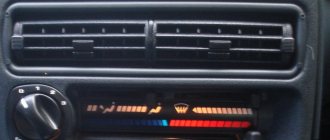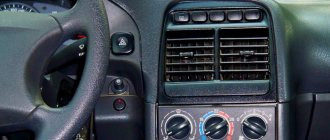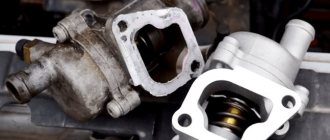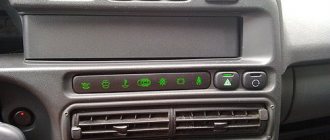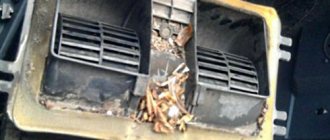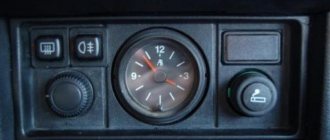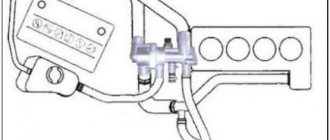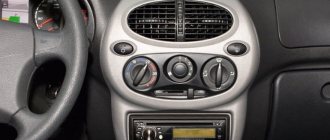A car as a means of transportation - this current slogan implies its use throughout the entire calendar year. The modern rhythm of life really forces you to get into the car, regardless of the time of day and current weather conditions. But in Russian conditions in winter they can be quite severe. And if it’s cold outside, then the driver and passengers will feel uncomfortable inside the car if the heating system is not working well enough. Unfortunately, such situations are not so rare. But if the stove starts blowing cold air, this does not mean that the problem will disappear on its own as suddenly as it appeared.
Types of faults
First, let's figure out how the stove works in a car. A radiator is installed inside the car, connected to the engine cooling system. The antifreeze heated in the engine, passing through the heater radiator, gives off heat. A fan is installed nearby, which drives air through the radiator, while the air heats up and, already hot, flows through the air ducts into the cabin.
The design of the cooling system in a car
There are several types of stove malfunctions:
- no air flows;
- The stove heats up weakly.
There are reasons for each of them.
How to flush a car heater radiator
You can flush the heater radiator either on the car or with removal. At the same time, removing such a radiator is often difficult. For this reason, at the initial stage, you can try to flush the entire cooling system with special ready-made compounds. If this does not help, then the radiator needs to be removed.
After removal, it is possible to flush the radiator both outside and inside. External cleaning allows the heat exchanger to ventilate and generate heat. For internal cleaning you will need:
- powerful pressure of hot water;
- a set of cleaning products, compositions or solutions;
Flush the radiator by applying cleaner and water inside under low pressure. Please note that it is better to use special ready-made cleaning compounds. It is important to make sure in advance that the product is suitable for a particular radiator and the material it is made of. The reason is that radiators are made from different materials.
We also recommend reading the article on how to install an additional car heater pump. From this article you will learn how to make the stove radiator work more efficiently, as well as how to install an additional pump on the stove.
As a result, the use of, for example, acids, caustic soda, alkalis or caustic solvents can damage rubber and plastic parts, as well as the radiators themselves made of copper, aluminum, etc. Also, preparing cleaning solutions at home is associated with a high risk of injury, chemical burns or poisoning.
Why doesn't it blow at all?
This can happen in two cases: the stove fan does not work, or the air does not pass through. The operation of the fan is usually audible, so there should not be any problems in determining the cause. If you can hear the fan, but no air flows, it means that its path is blocked by dampers that control air flow, or by foreign objects, for example, leaves. Rarely seen. To eliminate the cause, you need to check all the air ducts. Debris accumulates near a large obstruction, such as a radiator.
Dirt in the car radiator
If there is no debris, you need to check the dampers. Most often, their drive fails, for example, the cables jam or jump out of their fastening points. What needs to be corrected in this case can usually be seen after disassembly. Violation of the tightness of air duct connections is a very rare problem. The air flow does not reach the blowing nozzles, but is blown inside the dashboard. Here you need a sequential inspection of all connection points. If the cabin filter is very dirty, air passes through it with great difficulty. The interior is not ventilated properly.
You just need to change the filter. Of course, if you changed it recently, it has nothing to do with it. Another reason that the air does not flow: the fan is spinning in the wrong direction. But this only happens if something was done to it, for example, it was changed and installed incorrectly. In such a situation, you need to check the polarity of the fan connection (plus to plus, minus to minus).
What to do first
In order not to get buried in the abundance of reasons, it is necessary to act from simple to complex. Leave the frightening thoughts of a broken cylinder head gasket and take a trifling attitude, as if the electric damper actuator has failed. Actually, that's where we'll start.
Check the operation of the climate control shutters
Turn the knob or rocker of the climate system and evaluate the temperature of the incoming air. For example, with “blue all the way” the air should be noticeably cold, and with the maximum red settings it should be warmer.
Immobilized valves will not be able to mix flows according to the specified °C value. Therefore, at any position of the regulator, air will blow at the same temperature. The dampers stop as a result of damaged fasteners or a failed servomotor.
Attention. If the cooling system has a tap installed on the stove, check its position. Must be open.
Is the antifreeze level in the expansion tank stable?
Lift the hood, find the “extender” and the boundary marks on it. When cold, the antifreeze level should be between the MIN and MAX marks. If the tank is constantly emptying, look for leaks. You can look at where the coolant goes using the Lada Vesta as an example.
Heater radiators of some cars, for example Lada Kalina, are very sensitive to the amount of antifreeze in the expansion tank. At the slightest leak, the engine heats up, and the stove is cold or barely warm. And in general, when liquid flows out, air comes in and thus the system becomes airy.
Advice. It is better to look for small leaks under pressure. For example, adapt a regular spool valve from the chamber to the “expander” and create pressure in the tank with a bicycle pump.
Inspect the heater radiator for unobstructed circulation
Find two pipes going to the heater heat exchanger near the engine shield and touch them. The radiator assembly is embedded in a small circle in parallel, which means that the hoses should warm up immediately after starting the engine. It is better to carry out work when the engine is warmed up.
If one of the tubes is cold and the other is warm, the radiator is clogged or airy. First, rule out the presence of a dirt plug: pull off the outlet hose and evaluate the flow - practically nothing will flow out of a clogged radiator installation. Isn't that the point? Then feel free to expel the air.
Why doesn't the heater fan work?
Heater fan not working
The stove fan does not work if:
- The fan fuse has blown;
- The heater switch is faulty;
- Problems with wiring, connection reliability;
- The fan motor has failed.
The simplest thing is a blown fuse. In this case, simply replace it with a new one. However, if the fuse burns out again, you need to look for the cause, a short circuit somewhere. The fan switch can be easily checked by shorting the wires that go to it. Find out which terminals of the switch should close and jump the corresponding wires. The fan started spinning - the problem was found. Switches are usually non-removable, so replace the one that is faulty immediately.
Article on the topic: Types and design of a seat belt, why it is needed
Problems with wiring rarely occur, but if in doubt, check that all connections are secure and that there are no oxidized contacts or broken wires. If suspicions for all of the above reasons are not justified, it means that the motor itself is faulty. It is also usually beyond repair and will need to be replaced.
Faulty heater motor must be replaced
Water pump
If the stove blows cold air at idle, then the cause of the malfunction may be worn impeller blades.
This mainly happens when the car is no longer fresh or different coolants were used in the system. What is happening at this moment? A worn pump impeller at low engine speeds cannot create optimal pressure in the system for full circulation of antifreeze. To fix this problem, you simply need to replace the pump.
Why the stove does not heat well - cooling system malfunctions
This group of breakdowns not only affects the heat in the cabin, but also interferes with the normal operation of the engine. Therefore, she needs to pay special attention.
Thermostat
Cooling circuits in a car
One of the most common breakdowns is thermostat failure. The thermostat is a "switch". It determines the path along which the coolant moves. If it breaks and antifreeze is constantly pumped through the main radiator, the engine will warm up for a very long time, and at low temperatures it will not heat up at all. To find out that the thermostat is faulty, firstly, you need to look at the coolant temperature gauge. In the event of a breakdown, the temperature does not rise for a very long time. Secondly, you need to touch the hose coming from the main radiator. The hose should begin to heat up after the engine warms up, when warm air comes out of the stove. Otherwise, the thermostat needs to be replaced.
water pump
Another common malfunction of the cooling system is the ineffective operation of the pump, that is, the pump pumping antifreeze. The pump stops working normally in the following cases:
- its drive is faulty (the belt is broken);
- it is jammed (the bearing has failed);
- the impeller (blades that drive coolant) rotates;
- The impeller has collapsed and is no longer pumping as efficiently.
The consequence of this will be that in one place of the system it will be hot and in another cold, the engine will overheat, which you will see on the coolant temperature indicator. If the water pump still pumps, but with less efficiency, the heater will heat only at high speeds, since an insufficient volume of liquid for normal heating passes through the heater radiator at idle speed, and cold air blows from the heater.
Cylinder head gasket
If the gasket located between the cylinder block and its head is broken or burned out, gases from the cylinders enter the antifreeze. Signs are white smoke coming from the exhaust pipe and a sharp rise in the coolant level, gurgling in the expansion tank. This is a serious problem. You'll have to disassemble the engine.
Air entering the system
If the stove heats only at speeds above idle, this is a clear sign that there is air in the cooling system. The thermal conductivity of air is low, so it cannot transfer heat quickly. This adversely affects not only the operation of the heater, but also the entire engine as a whole. The design of the stove is such that its radiator is the most likely place for air to accumulate. If the intensity of coolant movement is not enough, the air is not expelled from the radiator by antifreeze, for example, at idle, and the stove does not heat up.
Article on the topic: The car battery is running low - what could be the reasons?
The heater in the car blows cold air
A sure sign that air has got in: the heater does not heat well at idle, and when the speed increases, gurgling, fluid overflowing is heard in the heater area, and hot air begins to blow. We need to find out why air got into the cooling system. This could be if the system is leaking somewhere and air is being sucked in. The cause may also be a low amount of coolant. Before adding coolant, be sure to find and eliminate the reason for its disappearance. If after replacing the radiator of the stove it does not heat well, the problem, again, is air getting in. How to properly remove air from the system, see the information specifically for your car. To get rid of the air lock in the heater radiator, disconnect the hoses from it, and pour antifreeze into the upper one, and drain it from the lower one, and continue this until air bubbles stop coming out along with the liquid. On some models, to get rid of air in the cooling system, it is enough to stand at a certain angle to the horizon and let the engine run at speeds above idle.
How to properly warm up a car in cold weather
Every car needs proper warming up in winter. Even a novice driver should know exactly how to heat it. The most important thing here is that the car must be warmed up in advance (15–20 minutes before the planned trip). This way it will work most efficiently, even despite the sub-zero temperature.
1. Preparing the car engine for starting
Before you start the engine, you should briefly turn on the low beams. It only takes half a minute for the battery to “wake up”. Then we depress the clutch so that the starter is disconnected from the crankshaft and gearbox. After that, turn on the neutral gear.
This will make starting the engine easier, despite the severe frost. Does your car run on diesel fuel? Then we wait until the spiral of the diesel heating plugs goes out. It is best to do this manipulation with glow plugs 2-3 times.
2. Starting the engine
It happens that the engine does not start immediately. You should not immediately try to start the car again. This will only drain the battery and ruin the starter. It will only take 30-40 seconds to restore the battery, after which the car should start.
Finally, the car started. Don't rush to warm up the windshield. Wait a couple of minutes. The engine has not yet warmed up enough to allow energy to be drawn from it.
We do not recommend turning on hot air blowing on the glass. There are probably microcracks on the windshield, so you will only make them bigger. To begin with, the air flow should be directed into the interior, then you can switch it to the glass. This way the car will warm up correctly in winter.
Now that the car has started and heated air enters the cabin, we begin to clear the snow from the outside of the car. This way you will spend every minute of your precious time wisely.
Carefully remove snow from the windshield and side windows. The cleaner they are, the better the driver will be able to see the road situation during the trip.
In the cold season, the car will take longer to warm up, the lower the temperature outside. Warming up also affects how actively the machine is used. Usually 15–20 minutes are enough for the car to warm up well.
3. Start of movement
A cold engine will run at higher speeds and idle. Once the car starts, the tachometer will show 1,200–1,300 rpm. When you finish warming up the engine, this figure will drop to a stable 1,000 rpm.
Have you noticed a drop and stabilization in speed? This means the car is ready to go. Moreover, at the very beginning of the movement (10–15 minutes), the car should drive at low speeds. You should drive 1,000 meters moving no more than 40–60 km per hour. Then gradually increase your speed.
By doing this you will give the engine enough time to warm up. Otherwise, the motor will experience high loads, its parts will wear out quickly, and the machine will break down.
Heating system malfunctions
If there are no complaints about the operation of the cooling system, then the reason is in the stove itself. That is, hot antifreeze is supplied to it, but cannot pass through it and transfer heat to the interior. There are two obstacles to this: the radiator and the heater tap.
Heater radiator
Clogged heater radiator in a car
Another reason why the heater in the car does not heat is that the heater radiator is clogged. Hot antifreeze cannot pass through it, and, naturally, does not heat up. This happens if:
- A variety of cooling system sealants were used;
- The car was operated for a long time on low-quality antifreeze or water;
- The radiator, like the car, is many years old.
All this leads to the accumulation of dirt in the cooling system. The heater radiator has one of the narrowest channels, the fluid flows there slowly to give off more heat, so it suffers first of all. In this case, it is necessary to flush or replace the heater radiator.
Faucet
Another reason why liquid does not flow through the radiator is a closed heater tap. As a rule, it is present only on older car models. There are two reasons: the tap itself is faulty, for example, it gets stuck in the closed position, or the drive to control it. The drive, usually a cable, has most likely come off its mounts. Then it needs to be secured. The heater valve assembly is replaced.
Faucet in the heating system in a car
On modern cars there is no faucet, but there is a damper that closes the heater radiator if hot air is not needed. A breakdown of the drive of this damper or its jamming also leads to the fact that the stove in the car does not heat well.
What to do to ensure that the stove always works properly
To protect yourself from unexpected breakdowns at the most inopportune moment:
- Check the condition of the radiator. Clean the outside of it from debris and dust, and when replacing the fluid, descale it.
- Do not fill the radiator with water even in the summer season, this leads to scale formation and clogging of the honeycombs. Use high-quality antifreeze; this approach will ensure uninterrupted operation of the heater and extend the life of the car engine.
- Don't forget about the cabin filter. In most cars it takes 30-50 minutes to change, do this at least once a year.
If the heater does not work as usual, take primary measures: check the condition of the radiator and fuses, replace the cabin filter and antifreeze.
Maintenance of the ventilation/cooling system
Experienced drivers know what troubles a sudden failure of the stove can cause. In order for it to serve for a long time and without failure, you must adhere to the following simple recommendations:
- Always keep the radiator clean. Small stains should be removed immediately using a vacuum cleaner or rags. It is much more difficult to get rid of internal deposits. The procedure for flushing the cooling system of the power unit can cope with this task, since the furnace radiator is included in both circuits of this system;
- Use only high quality coolant. Remember that in this case you are extending the life not only of the component of the ventilation system, of which the heater is part, but also of the engine;
- Don't forget to change the cabin filter on time. If it is clogged, then this is a guaranteed problem in the operation of the stove, the ventilation system as a whole, and the air conditioning system, if any. Accumulation of pollutants on the filter can pose a danger to passengers, especially those with allergies;
- in frosts exceeding 25 degrees, a working heater warms up the interior in the lower part to plus 16 degrees and up to 10 at the top. If the car does not have a climate system, it is advisable to purchase a thermometer, based on the readings of which you can draw conclusions about the serviceability of the stove.
Tips for warming up your car quickly
- Monitor the technical condition of all components of the car heater: radiator, fan, cabin filter, electronics, promptly replace failed parts.
- When warming up the car in severe frost, do not set the heater control to the maximum position: the engine and interior will heat up much more slowly. It is enough to set the regulator to the initial position or to “1”.
- During extreme cold weather, owners of cars with a small engine are advised to take additional measures to help the engine quickly reach the desired temperature, for example, cover the unit with a blanket for a short time or block the air supply to the main radiator with cardboard.
Video on the topic
Sources
- https://KrutiMotor.ru/pechka-duet-holodnym-vozduhom-prichiny/
- https://autostadt.su/pechka-duet-cholodnym-vozduchom/
- https://unit-car.com/diagnostika-i-remont/204-ploho-greet-pechka-v-mashine.html
- https://HyperAuto.ru/articles/poleznaya-informaciya/pochemu-pechka-duet-holodnym-vozduhom-7-osnovnyh-prichin/
- https://avtika.ru/pochemu-duet-holodnyy-vozduh-pri-progretom-dvigatele/
- https://avtika.ru/pochemu-pri-progretom-dvigatele-pechka-duet-holodnym/
- https://FB.ru/article/230103/pechka-duet-holodnyim-vozduhom-prichinyi-remont
- https://auto-sovets.ru/svoimi-rukami/ne-rabotaet-pechka-v-mashine-prichiny-polomki-i-neispravnosti.html
- https://autochainik.ru/ne-greet-pechka-v-mashine.html
- https://DriverTip.ru/repair/pechka-otopitelya-v-mashine-duet-holodnym-vozduhom.html
- https://AvtoNov.com/%D0%BF%D0%BE%D1%87%D0%B5%D0%BC%D1%83-%D0%BD%D0%B5-%D0%B3%D1%80 %D0%B5%D0%B5%D1%82-%D0%BF%D0%B5%D1%87%D0%BA%D0%B0-%D0%B2-%D0%BC%D0%B0%D1% 88%D0%B8%D0%BD%D0%B5-%D0%BF%D1%80%D0%B8%D1%87%D0%B8%D0%BD%D1%8B/
- https://nahybride.ru/salon/pechka-duet-holodnym-vozduhom
Warm-cold regulator drive
This system mechanism can cause the heater to blow cold air. The reason lies in the control drive device itself. Basically, all control devices of this type are equipped with metal cables.
At a certain point, the switch may get stuck in one position. At that moment, if the regulator is stuck in the “warm” position, then warm air will begin to flow into the cabin. Its temperature will depend on the degree of opening of the damper at the moment of jamming. But if the damper control is stuck in the closed position, the stove blows cold air.
Regardless of what the controls and controls for the heater dampers and taps look like (lever, wheel, dial switch), the malfunction is the same. Often there is a break in the traction elements (cable, rod) from the fastenings on the valves and control levers. Less often, the cables become clogged and rust in the protective case and do not move well in it.
At a time when the stove is blowing cold air due to a malfunction of the control drives, and it is not possible to carry out a full repair (for example, on the road), you need to manually move the shut-off valves to the “open” position. In cars in which the temperature control is driven by electronic mechanisms, first of all you need to check the condition of the system fuses. But generally it is recommended to contact the nearest car service center.
What to do if the stove adjustment does not work
Another problem is the malfunction of the switch. The control mechanism itself includes several elements. These are regulators of temperature, operating modes, distribution of air masses, and the lever that switches the damper is also turned on.
If the stove adjustment does not work, it is necessary to study the main reasons for the development of problems.
Possible reasons:
- The shift control cable is faulty. Then it moves normally only in one direction, not reaching the other side.
- Abrupt switching on or off leads to mechanical failure. The switch needs to be replaced.
- Problems associated with the thermistor appear in the form of one operating mode. For example, the heater can only operate at speed 4. This will require installing a new element.
- A breakdown of the temperature sensor disrupts the operation of the system. Replacement is required to eliminate the defect.
- Problems with wiring - a violation of the integrity of the connection affects the operation of the regulation system. Repair involves restoring the wire.
How to repair the mode switch and replace faulty parts:
- work begins with disconnecting the negative terminal, removing the assembly and disassembling;
- it is necessary to remove the radio and turn off the power;
- further, the damper switch lever, temperature regulator, and flow distribution are dismantled;
- by removing the plugs at the bottom, you can easily unscrew the screws, which will make it possible to dismantle the console;
- The power connectors are easy to find in the back; you need to unplug them.
After performing such manipulations, you can begin to eliminate the defect, depending on the detected breakdown.
Assembly is performed in reverse order.
Separately, it is worth highlighting situations when the second position of the stove does not work. If only one speed does not function, the problem lies in the resistor, its contacts, springs, and wires. The part is located under the panel in the gas pedal area on the right side.
What to do to fix the problem - you need to replace the device or check the wires, which sometimes fall off or burn out.
